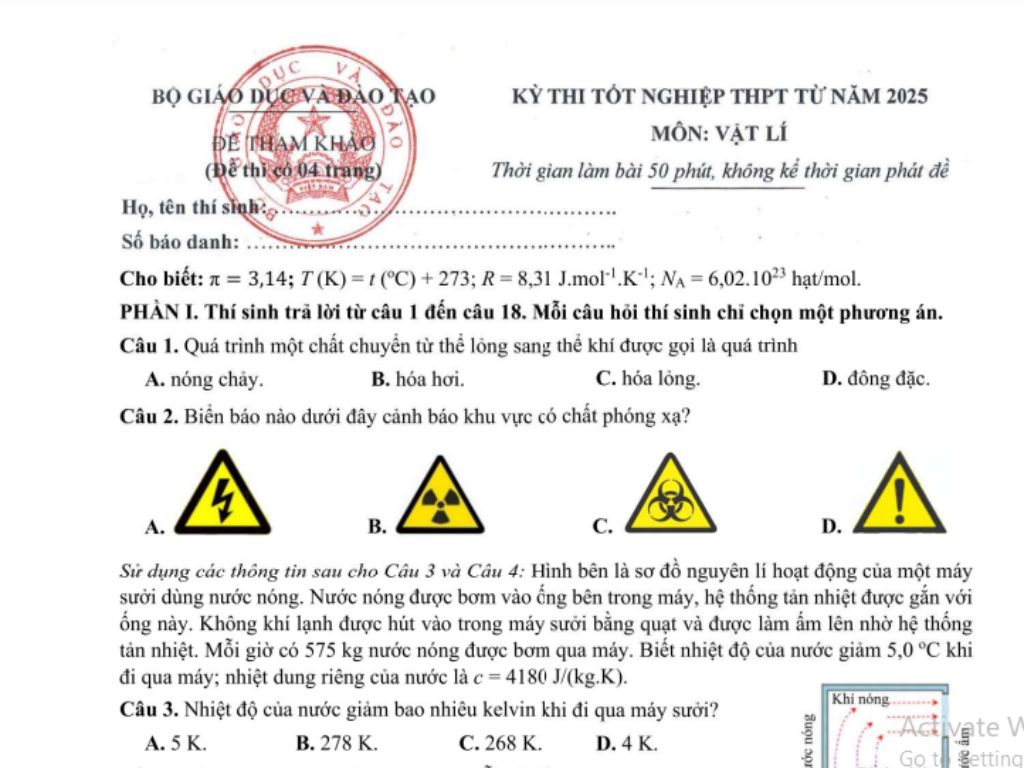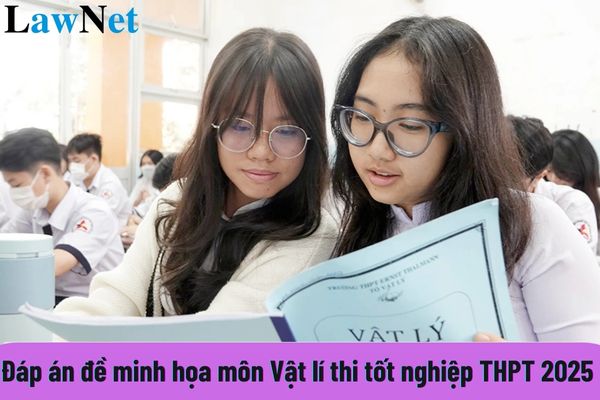What are the newest answers to the illustrative question papers for Physics in the High School Graduation Exam 2025? What are the three academic topics in the 12th-grade Physics curriculum in Vietnam?
What are the newest answers to the illustrative question papers for Physics in the High School Graduation Exam 2025?
Below are answers to the illustrative question papers for Physics in the High School Graduation Exam 2025:

Download the newest answers to the illustrative question papers for Physics in the High School Graduation Exam 2025

What are the newest answers to the illustrative question papers for Physics in the High School Graduation Exam 2025? What are the three academic topics in the 12th-grade Physics curriculum in Vietnam? (Image from the Internet)
What are the three academic topics in the 12th-grade Physics curriculum in Vietnam?
Under Section 5 in the General Education Program issued with Circular 32/2018/TT-BGDDT, the three academic topics in the 12th-grade Physics curriculum in Vietnam are specified as follows:
Topic 12.1. Alternating current
Characteristics of alternating current:
- Discuss to design a plan, choose a plan, implement the plan, and measure (or describe the measurement method): frequency and alternating voltage using practical tools.
- State: the average heat dissipation power on a pure resistor is half of the maximum power of sinusoidal alternating current (passing through this pure resistor).
- Describe using algebraic expressions or graphs: current intensity and alternating voltage; compare effective and maximal values.
- Discuss to design or choose and implement a plan, investigate the RLC alternating current circuit connected in series using practical tools.
Transformers:
- State the operating principle of transformers.
- State the advantages of alternating current and voltage in electric energy transmission from both scientific and economic perspectives.
- Discuss to evaluate the role of transformers in reducing energy loss during long-distance electric transmission.
Rectifying alternating current:
- Conduct experiments, and draw graphs depicting the relationship between current through a semiconductor diode and the voltage across its terminals.
- Draw the half-wave rectification circuit using a diode.
- Draw the full-wave rectification circuit using a bridge rectifier.
- Compare the half-wave and full-wave rectification graphs.
Topic 12.2. Some applications of physics in medical diagnostics
The nature and creation of X-rays:
- State how to create X-rays, how to control X-rays, and X-ray attenuation.
- Discuss to evaluate the role of X-rays in life and science.
Diagnosis using X-rays:
- Briefly describe how to take X-ray images.
- From images (multimedia materials), discuss to derive some methods to improve X-ray images: reduce dose, improve sharpness, improve contrast.
Ultrasound diagnosis:
- Briefly state how ultrasound is generated.
- Briefly state how to generate ultrasound images of internal structures.
- From images (multimedia materials), discuss to evaluate the role of ultrasound in life and science.
Tomography and magnetic resonance imaging:
- Briefly describe how to take tomographic images.
- Implement a project or research topic, design a simple tomography model.
- Briefly state the principles of magnetic resonance imaging.
Topic 12.3. Quantum physics
Photoelectric effect and photon energy:
- State the quantum nature of electromagnetic radiation and photon energy.
- Apply the formula for calculating photon energy, E = hf.
- State that the photoelectric effect is evidence of the particle nature of electromagnetic radiation, while interference and diffraction are evidence of its wave nature.
- Describe the concept of the photoelectric threshold and work function.
- Explain the photoelectric effect based on photon energy and work function.
- Explain: the maximum initial kinetic energy of photoelectrons does not depend on the light beam's intensity, and the saturation photocurrent intensity is proportional to the intensity of the light incident.
- Apply Einstein's equation to explain photoelectric laws.
- Estimate the energy of basic electromagnetic radiations on the electromagnetic spectrum.
- Discuss to design or choose and implement a plan, investigating photoelectronic current using practical tools.
Wave-particle duality:
- Describe (or explain) the wave nature of electrons through electron diffraction phenomena.
- Apply de Broglie's wavelength formula: λ = h/p with p as the particle's momentum.
Spectral lines of atoms:
- Describe the existence of quantum energy levels of an atom.
- Explain the formation of spectral lines.
- Compare emission spectra and absorption line spectra.
- Apply the energy level transition expression hf = E1 - E2.
Energy bands:
- State energy bands in solids using a simple energy band model.
- Use simple energy band theory to explain: The dependence on temperature of resistors in metals and undoped semiconductors and the dependence of the resistance of LDRs on light intensity.
In 2025, what are the cases where 12th-grade students in Vietnam can retain their high school graduation exam results?
Under Article 41 of Circular 24/2024/TT-BGDDT, the Regulation on the High School Graduation Exam from 2025,12th-grade students can retain their high school graduation exam results in the following cases:
- Candidates who have taken all the required exams but have not graduated from upper secondary education and are not subject to disciplinary action for annulling exam results are allowed to retain exam scores to be considered for recognition of high school graduation in the subsequent exam period. The paper must have a score of 5.0 or higher to be retained.
- Candidates with retained scores under Clause 1, Article 41 of Circular 24/2024/TT-BGDDT must register for the exam under point a, Clause 2, Article 20 of Circular 24/2024/TT-BGDDT (including subjects with retained scores) and only take the exams for subjects without retained scores to be considered for graduation recognition in the subsequent exam. If candidates retake a subject with retained scores, the result must be used for consideration for graduation recognition.
*Note: Circular 24/2024/TT-BGDDT on the Regulation on the High School Graduation Exam from 2025 takes effect from February 8, 2025.

